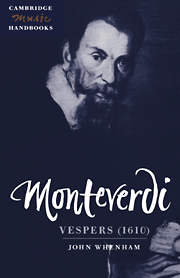Book contents
- Frontmatter
- Contents
- Acknowledgements
- List of abbreviations
- 1 Introduction
- 2 The 1610 settings and the liturgy of Vespers
- 3 The 1610 print and Monteverdi's career
- 4 ‘Suited to the chapels or chambers of princes’
- 5 ‘And all on a cantus firmus’
- 6 Issues of performance
- Appendices
- Notes
- Select bibliography
- Discography
- Index
3 - The 1610 print and Monteverdi's career
Published online by Cambridge University Press: 12 January 2010
- Frontmatter
- Contents
- Acknowledgements
- List of abbreviations
- 1 Introduction
- 2 The 1610 settings and the liturgy of Vespers
- 3 The 1610 print and Monteverdi's career
- 4 ‘Suited to the chapels or chambers of princes’
- 5 ‘And all on a cantus firmus’
- 6 Issues of performance
- Appendices
- Notes
- Select bibliography
- Discography
- Index
Summary
Monteverdi's Vespro della Beata Vergine was published while he was maestro di cappella at the Gonzaga court at Mantua in northern Italy. However, no performance of the Vespers, nor of any of its constituent parts, is known to have taken place at Mantua or, indeed, anywhere else during Monteverdi's lifetime; and there is little documentary evidence that relates directly to the composition and publication of the music. This is usual with respect to volumes of church music in the early seventeenth century, but it is often possible to relate such publications to the composer's career. At Mantua, however, Monteverdi was not, so far as we know, employed specifically as a church musician, and it is thus more difficult to account for his having produced a major collection of church music. The understandable frustration that this has caused for historians and performers alike has given rise to various hypotheses, some more solidly grounded than others, about why Monteverdi wrote and published this particular collection and why it takes the form that it does. Some of these can be evaluated fairly readily on the basis of documentary evidence, including the evidence of the publication itself, some require an understanding of the liturgical context, and others an understanding of circumstances in Monteverdi's career that might have prompted him to publish church music in 1610.
- Type
- Chapter
- Information
- Monteverdi: Vespers (1610) , pp. 23 - 40Publisher: Cambridge University PressPrint publication year: 1997



